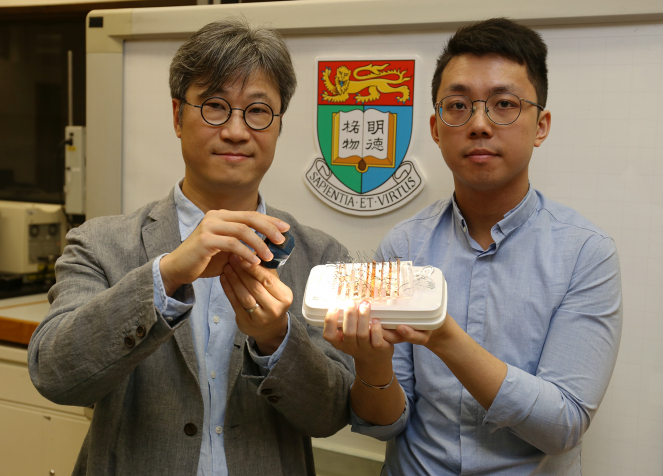Media
Future robots need no motors HKU Engineering invents world’s first nickel-hydroxide actuating material that can be triggered by both light and electricity
31 May 2018
To develop micro- and biomimetic-robots, artificial muscles and medical devices, actuating materials that can reversibly change their volume under various stimuli are researched in the past thirty years to replace traditional bulky and heavy actuators including motors and pneumatic actuators.
A mechanical engineering team led by Professor Alfonso Ngan Hing-wan, Chair Professor in Materials Science and Engineering, and Kingboard Professor in Materials Engineering, Faculty of Engineering, the University of Hong Kong (HKU) published an article in Science Robotics on 30 May 2018 (EST) that introduces a novel actuating material – nickel hydroxide-oxyhydroxide – that can be powered by visible (Vis) light, electricity, and other stimuli. The material actuation can be instantaneously triggered by Vis light to produce a fast deformation and exert a force equivalent to 3000 times of its own weight. The material cost of a typical actuator is as low as HKD 4 per cm2 and can be easily fabricated within three hours.
Among various stimuli, light-induced actuating materials are highly desirable because they enable wireless operation of robots. However, very few light driven materials are available in the past, and their material and production costs are high, which hinder their development in actual applications such as artificial muscles for robotics and human assist device, and minimally invasive surgical and diagnostic tools.
Developing actuating materials was identified as the top of the 10 challenges in “The grand challenges of Science Robotics”1. Research in actuating materials can radically change the concept of robots which are now mainly motor-driven. Therefore, materials that can be actuated by wireless stimuli including a change in temperature, humidity, magnetic fields and light is one of the main research focus in recent years. In particular, a material that can be actuated by Vis light and produces strong, quick and stable actuation has never been achieved. The novel actuating material system – nickel hydroxide-oxyhydroxide that can be actuated by Vis light at relatively low intensity to produce high stress and speed comparable to mammalian skeletal muscles has been developed in this research initiated by engineers in HKU.
In addition to its Vis light actuation properties, this novel material system can also be actuated by electricity, enabling it to be integrated into the present well-developed robotics technology. It is also responsive to heat and humidity changes so that they might potentially be applied in autonomous machines that harness the tiny energy change in the environment. Because the major component is nickel, the material cost is low. The fabrication only involves electrodeposition which is a simple process, and the time required for the fabrication is around three hours, therefore the material can be easily scaled up and manufactured in industry.
The newly invented nickel hydroxide-oxyhydroxide responses to light almost instantaneously and produces a force corresponding to about 3000 times of its own weight (Figure 1).
1 Yang, Guang-Zhong, et al. "The grand challenges of Science Robotics." Science Robotics 3.14 (2018): eaar7650.
When integrated into a well-designed structure, a “mini arm” made by two hinges of actuating materials can easily lift an object 50 times of its weight (Figure 2). Similarly, by utilizing a light blocker, a mini walking-bot in which only the “front leg” bent and straighten alternatively and therefore moves under illumination was made so that it can walk towards the light source (Figure 3). These demonstrate that future applications in micro-robotics including rescue robots are possible.
The evidences above revealed that this nickel hydroxide-oxyhydroxide actuating material can have different applications in the future, including rescue robots or other mini-robots. The intrinsic actuating properties of the materials obtained from our research show that by scaling up the fabrication, artificial muscles comparable to that of mammalian skeletal muscles can be achieved, and applying it in robotics, human assist device and medical devices are possible.
From a scientific point of view, this nickel hydroxide-oxyhydroxide actuating material is the world’s first material system that can be actuated directly by Vis light and electricity without any additional fabrication procedures. This also opens up a new research field on light-induced actuating behaviour for this material type (hydroxide-oxyhydroxides) because it has never been reported before.
The research team members are all from the Department of Mechanical Engineering at HKU Faculty of Engineering, led by Professor Alfonso Ngan’s group in collaboration with Dr Li Wen-di. ’s group on light actuation experiment and Dr Feng Shien-ping’s group on electrodeposition experiment. The research has been published in the prestigious journal Science Robotics on 30 May 2018 with a title of “Light-stimulated actuators based on nickel hydroxide-oxyhydroxide”. The first author of this paper is Dr Kwan Kin-wa who is currently a post-doctoral fellow in Prof. Ngan’s group. The corresponding author is Prof. Ngan. The complete author list is as below: K-W. Kwan, S-J. Li, N-Y. Hau, W-D. Li, S-P. Feng, A.H.W. Ngan. This research is funded by the Research Grants Council, Hong Kong.
For the journal paper, please click: http://robotics.sciencemag.org/content/3/18/eaat4051.full
For the powerpoint slides about this research, please click here, and for video clips, please click here. (Please credit “The University of Hong Kong” if adopt the images in the powerpoint and videos.)
Media enquiry:
Faculty of Engineering:
Dr Kwan Kin-wa (Email: kkwkwan@connect.hku.hk)
Professor Alfonso Ngan (Tel: 39177900; Email: hwngan@hku.hk)
Ms Rhea Leung (Tel: 3917-8519/ 9022-7446; Email: rhea.leung@hku.hk)
Communication and Public Affairs Office:
Ms Trinni Choy (Tel: 2859 2606/ Email: pychoy@hku.hk)
Ms Rashida Suffiad (Tel: 2857 8555/ email: rsuffiad@hku.hk)




